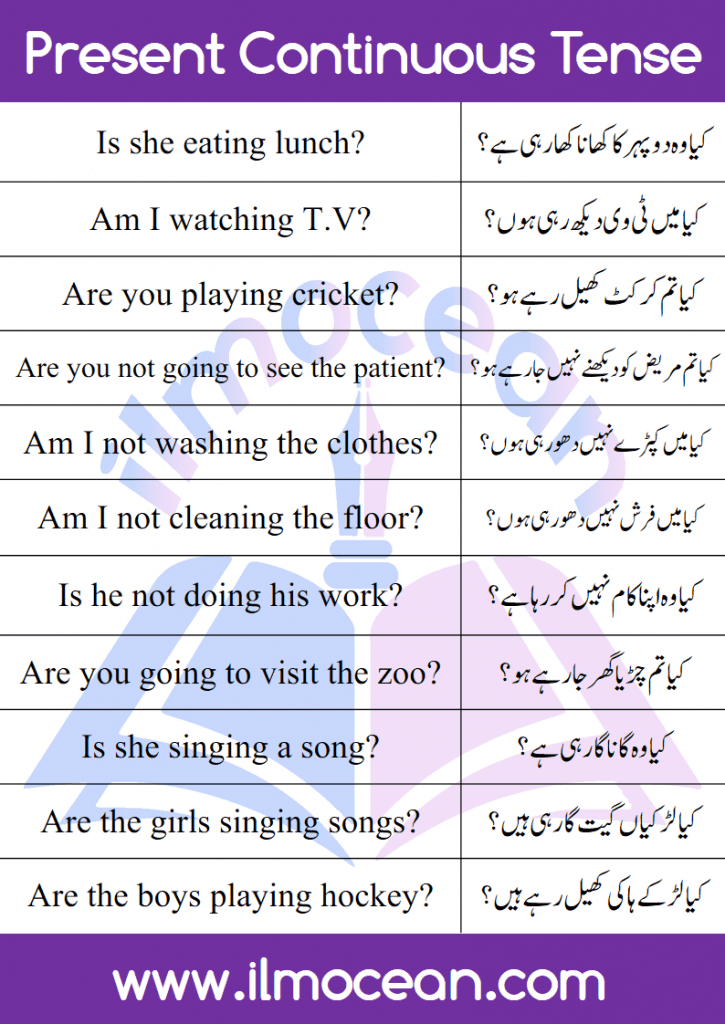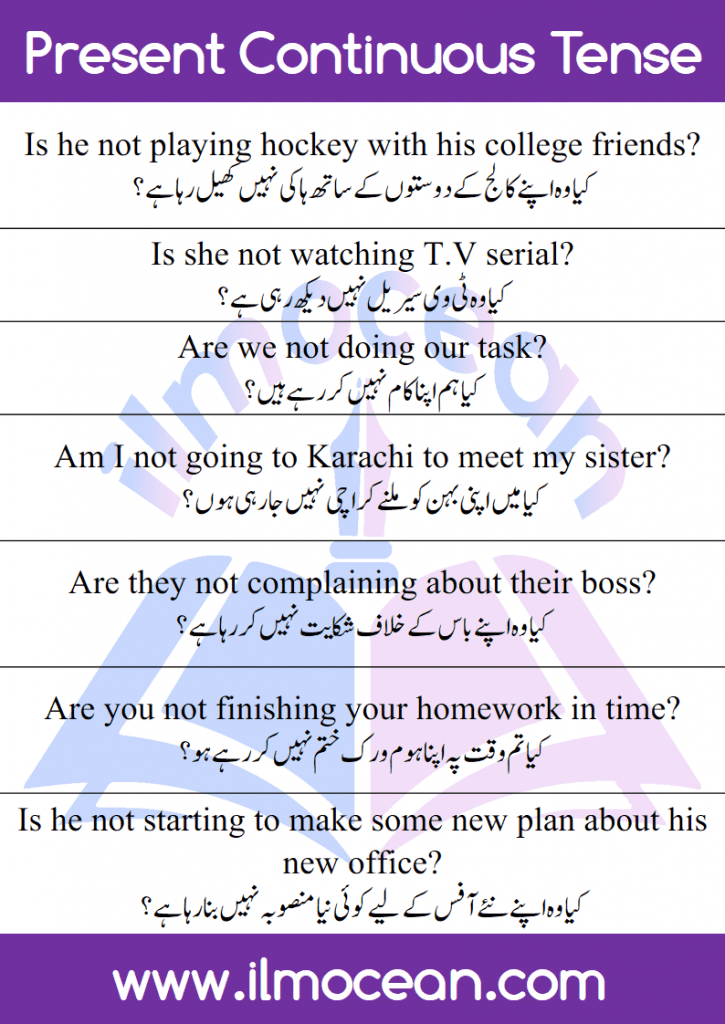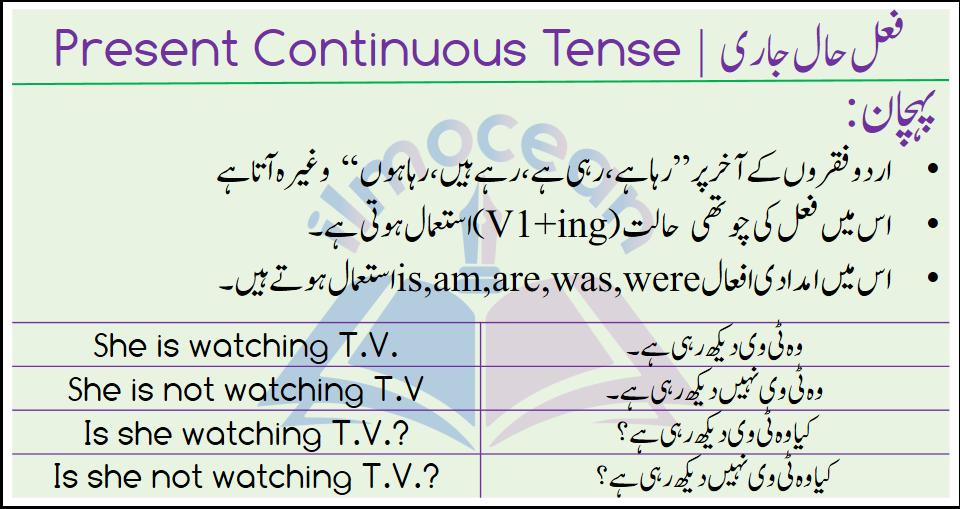Present Continuous Tense is used to describe those actions that are happening at present. It tells the actions that is going on and not completed. To describe such actions, e use Present Continuous Tense. These actions are usually happening at the time when the sentence is being said or written.
یہ ٹینس ایک ایسا ایکشن ظاہر کرتا ہے جس میں کسی کام کا کرنا , ہونا یا سہنا موجودہ دور میں جاری حالت میں پایا جاتا ہے ۔
فقرے کے آخر میں رہا ہے ، رہی ہے ، رہے ہیں ، رہا ہوں وغیرہ آتا ہے ۔
The present continuous (also called Present Progressive) is a verb tense which is used to show the ongoing action. Read on for detailed descriptions, examples, and past continuous exercises.
- Present Continuous Tense uses Fourth Form of Verb (V1-ing).
- Helping verbs are Is Are Am.
Is = he, she, it, singular
Are = we, you, they, plural
Am = I
- We use Fourth Form of Verb (v1+ing) in this tense. In Positive sentences and negative sentences, structure is same but only difference is the addition of NOT in negative sentences. Structures of both positive and negative sentences is given below.
Subject + is/am/are + v1-ing + object.
Subject + is/am/are + not + v1-ing + Object.
- While in interrogative sentences, we have to use the helping verbs at the start of sentence. Helping verb is always placed before the Subject in interrogative sentences. Structure of interrogative sentences is given below
Is/am/are + Subject + v1-ing + Object ?
One example of this tense is: I am playing cricket. The Present Continuous Tense is “am playing.” Questions are indicated by inverting the subject and is/am/are. Negatives are made with not
Simple: I am eating pizza
Question: Am I eating pizza?
Negative: I am not eating pizza
Positive Sentences:
These sentences are also called affirmative sentences and simple sentences. These sentences are very easy to create. Just use the following structure to create these sentences in the simples way.
Subject + is/am/are + v1-ing + object.
- Subject = Action doer, the performer of the task
- Object = The one which receives the action of subject
| She is watching T.V. | وہ ٹی وی دیکھ رہی ہے ۔ |
| He is playing cricket. | وہ کرکٹ کھیل رہا ہے ۔ |
| They are going to Lahore. | وہ لاہور جا رہے ہیں ۔ |
| I am going to Murree. | میں مری جا رہی ہوں ۔ |
| You are eating lunch. | تم دوپہر کا کھانا کھا رہے ہو ۔ |
| You are sitting on this sofa. | تم اس صوفے پر بیٹھ رہے ہو ۔ |
| I am watching T.V. | میں ٹی وی دیکھ رہا ہوں۔ |
| They are singing songs. | وہ گیت گا رہے ہیں۔ |
| We are trying to learn thus lesson. | ہم یہ سبق یاد کرنے کی کوشش کر رہے ہیں۔ |
| I am enjoying this film. | میں یہ فلم انجوائے کر رہا ہوں ۔ |
| You are singing a song. | تم گیت گا رہے ہو۔ |
| She is dancing in the party. | وہ پارٹی میں ڈانس کر رہی ہے۔ |
| I am playing badminton. | میں بیڈ منٹن کھیل رہا ہوں ۔ |
| They are going to the zoo. | وہ چڑیا گھر جا رہے ہیں۔ |
Negative Sentences:
Negative sentences are just a positive sentences with only one difference and that difference is NOT. Structure of the sentences is given below
Subject + is/am/are + not + v1-ing + Object
| She is not singing a song. | وہ گانا نہیں گا رہی ہے ۔ |
| They are not playing hockey. | وہ کرکٹ نہیں کھیل رہے ہیں۔ |
| You are not displaying this dress. | آپ یہ ڈریس نہیں دکھا رہے ہیں۔ |
| I was not making breakfast. | میں ناشتہ نہیں بنا رہی ہوں۔ |
| I was not washing clothes. | میں کپڑے نہیں دھو رہی ہوں۔ |
| He is not coming to see me today. | وہ مجھے دیکھنے نہیں آرہا ہے ۔ |
| They are not eating fries. | وہ فرائز نہیں کھا رہے ہیں۔ |
| I am not playing hockey. | میں ہاکی نہیں کھیل رہی ہوں۔ |
| She is not writing a letter. | میں خط نہیں لکھ رہی ہوں۔ |
| You are not completing this work. | تم یہ کام مکمل نہیں کر رہی ہو۔ |
| They are not sleeping in the room. | وہ گراوؑنڈ میں نہیں سو رہے ہیں۔ |
| They are not cleaning the floor. | وہ فرش صاف نہیں کر رہے ہیں۔ |
| I am not ironing the clothes. | میں کپڑے استری نہیں کر رہی ہوں۔ |
| She is not drinking water from her new bottle. | وہ اپنی نئی بوتل سے پانی نہیں پی رہی ہے۔ |
Interrogative Sentences:
Those sentences which are used to ask questions are called Interrogative Sentences. These are denoted by putting a question mark at the end. In Present Continuous Tense, helping verbs is are am are used before the subject. Structure of interrogative sentences in Present Continuous Tense is given below
Is/am/are + Subject + v1-ing + Object?
| Is she eating lunch? | کیا وہ دوپہر کا کھانا کھا رہی ہے؟ |
| Am I watching T.V? | کیا میں ٹی وی دیکھ رہی ہوں؟ |
| Are you playing cricket? | کیا تم کرکٹ کھیل رہے ہو؟ |
| Is she playing badminton with the youngest girl of the university? | کیا وہ یونیورسٹی کی سب سے چھوٹی لڑکی کے ساتھ بیڈ منٹن کھیل رہی ہے ؟ |
| Are you not going to see the patient? | کیا تم مریض کو دیکھنے نہیں جا رہے ہو؟ |
| Am I not washing the clothes? | کیا میں کپڑے نہیں دھو رہی ہوں ؟ |
| Am I not cleaning the floor? | کیا میں فرش نہیں دھو رہی ہوں ؟ |
| Is he not doing his work? | کیا وہ اپنا کام نہیں کر رہا ہے ؟ |
| Are they not protesting against dearness of the country? | کیا وہ ملک میں مہنگائی کے خلاف احتجاج کر رہے ہیں؟ |
| Are you going to visit the zoo? | کیا تم چڑیا گھر جا رہے ہو؟ |
| Is she singing a song? | کیا وہ گانا گا رہی ہے ؟ |
| Are the girls singing songs? | کیا لڑکیاں گیت گا رہی ہیں ؟ |
| Are the boys playing hockey? | کیا لڑکے ہاکی کھیل رہے ہیں؟ |
| Am I washing my face with new face wash? | کیا میں نئے فیس واش کے ساتھ چہرہ دھو رہی ہوں ؟ |
| Am I singing a song for my lovely friend? | کیا میں اپنی پیاری دوست کے لیے گانا گا رہی ہوں ؟ |
Interrogative +Negative Sentences:
Is/am/are + Subject + not + v1-ing + Object?
| Is he not playing hockey with his college friends? | کیا وہ اپنے کالج کے دوستوں کے ساتھ ہاکی نہیں کھیل رہا ہے ؟ |
| Is she not watching T.V serial? | کیا وہ ٹی وی سیریل نہیں دیکھ رہی ہے ؟ |
| Are we not doing our task? | کیا ہم اپنا کام نہیں کر رہے ہیں؟ |
| Am I not going to Karachi to meet my sister? | کیا میں اپنی بہن کو ملنے کراچی نہیں جا رہی ہوں؟ |
| Am I not starting new project with my new principal? | کیا میں اپنی نئی پرنسپل کے ساتھ نیا پراجیکٹ شروع نہیں کر رہی ہوں؟ |
| Are they not complaining about their boss? | کیا وہ اپنے باس کے خلاف شکایت نہیں کر رہا ہے ؟ |
| Are you not finishing your homework in time? | کیا تم وقت پہ اپنا ہوم ورک ختم نہیں کر رہے ہو؟ |
| Is he not starting to make some new plan about his new office? | کیا وہ اپنے نئے آفس کے لیے کوئی نیا منصوبہ نہیں بنا رہا ہے ؟ |
| Is he not making new sketches of his new dress? | کیا وہ اپنے نئے ڈریس کا نیا خاکہ نہیں بنا رہا ہے ؟ |
| Am I not going to Murree to see snow falling? | کیا میں برف باری دیکھنے مری نہیں جا رہی ہوں؟ |
Download PDF Here






